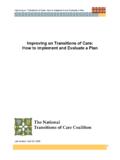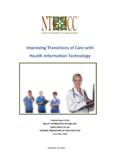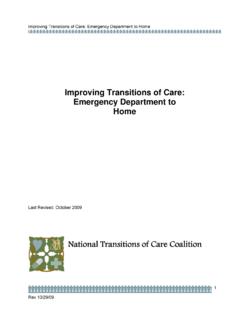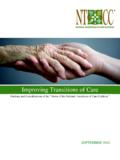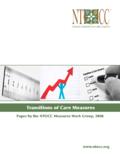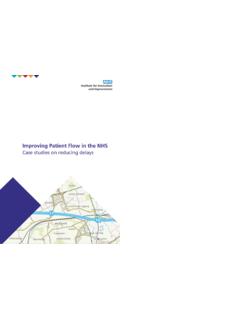Transcription of Improving Transitions of Care: Hospital to Home
1 Improving Transitions of care : Hospital to Home 1 Improving Transitions of care : Hospital to Home Last Revised: October 2009 National Transitions of care Coalition Improving Transitions of care : Hospital to Home 2 Acknowledgement This guidebook was written and compiled by Insight Therapeutics, LLC, ( ) and represents expert opinion. The Performance & Metrics Work Group of NTOCC provided strategic direction through its work in defining a framework for measuring transitional care , and review of various guidebook drafts. NTOCC Performance & Metrics Work Group Mary Fermazin, MD, MPA VP, Health Policy & Quality Measurement Health Services Advisory Group, Inc.
2 (HSAG) Hussein Tahan, DNSc, RN, CNA New York Presbyterian Hospital James E. Lett II, MD, CMD Chief Medical Officer for Long-Term care California Prison Health care Services Joann Richards, PhD, RN Vice President for Research and Measurement URAC Funding Acknowledgement This project was funded under a contract from NTOCC, which is chaired and coordinated by the Case Management Society of America and sponsored by sanofi-aventis LLC. For more information Please visit the NTOCC website, , for additional contact information. Improving Transitions of care : Hospital to Home 3 CONTENTS 4 5 5 Evaluating and Improving Transitions of care in Your 7 Step 1.
3 Select What You Plan to 7 Step 2. Assess the Current 8 Step 3. Determine Your Current Level of 14 Step 4. Determining Your Intervention 24 Step 5. Implementing Your Intervention 28 Step 6. Determine Your Degree of 30 Step 7. Make Any Modifications Necessary to the 32 35 Appendix A: Preparation at Home for the Hospital 36 Appendix B: Hospital Receipt of 38 Appendix C: Patient Receives care Through 49 Appendix D: Evaluation: A Basic 52 Appendix E: Literature Review - Transitions From the Hospital to 59 Appendix F: Institute for Healthcare Improvement Tips for Effective 63 Appendix G: NTOCC 64 Suggested Common/Essential Data Elements for Medication 64 My Medicine 65 Elements of Excellence in Transitions of care (TOC) 66 Appendix H: NTOCC Proposed Framework for Measuring Transitions of 67 Appendix I.
4 Interventions for Low Health 68 Appendix J. Sample Heart Failure Standardized Discharge 69 Appendix K: Annotated Bibliography and 71 Appendix L: transition of care Intervention 75 Improving Transitions of care : Hospital to Home 4 Forward NTOCC believes in the commitment of healthcare workers, practitioners, and leaders and in their ability to make a difference in Improving Transitions of care . To further NTOCC s reach for Improving the quality of care Transitions , we have added to our Implementation and Evaluation Plan by offering additional modules: the Hospital to home and the emergency department to home Transitions .
5 The methodology used here is the same for the introductory module released in 2008 implement a plan and evaluate it to see how it is working. This document is intended to be used in conjunction with the original document, Improving on Transitions of care : How to Implement and Evaluate a Plan. This plan includes evaluation questions, acceptable metrics or measures, tools, and tips applicable to hospitals, home caregivers, and primary care offices. As with other NTOCC strategies, communication is the most important component of any plan, tool, or quality improvement effort. Thank you for your continued dedication to making Transitions safer.
6 Cheri Lattimer Executive Director, Case Management Society of America NTOCC Project Director Improving Transitions of care : Hospital to Home 5 Introduction Patients face significant challenges when moving from one care setting to another within the fragmented health care system. As currently structured, the health care system does not meet the needs of many patients during Transitions between health care settings. The system s problems have culminated in medical errors and gross mismatches of health care resources to needs. (MR Chassin JAMA 1998.) Not only can poor Transitions lead to poor care quality, Transitions of care issues pose a financial burden for the health insurers, the government, and patients.
7 A constant in all episodes of care is the patient, who, with sufficient education and empowerment, can proactively facilitate necessary communication and interaction between providers. In order to improve health care in this country, patients and providers must ensure better information exchange at all stages of the health care process, and patients and their caregivers should actively participate in a standardized communication plan. Background The term " Transitions of care " connotes the scenario of a patient leaving one care setting ( Hospital , nursing home, assisted living facility, skilled nursing facilities, PCP, home health, or specialist) and moving to another.
8 The care transition frequently involves multiple persons, including the patient, family or other caregiver, nurses, social workers, case manager, pharmacists, physicians, and other providers. An optimal transition should be well planned and adequately timed. Research has shown that communication between settings or providers often fails to supply all of the information needed for optimum care . Several studies in recent years have shown that deficiencies in health literacy, patient education, appropriate medical follow-up, and communication among health care providers to be associated with adverse events following Hospital discharge.
9 The Office of the Inspector General reported in 2006 that 34,500 patients in 1996 and 1997 were discharged and readmitted on the same day, costing the system more than $226 million. ( ) In the year since the original Implementation and Evaluation plan, there are number of new publications on Transitions of care and quality improvement (See Appendix K). The Institute for Healthcare Improvement, under funding from the Robert Wood Johnson Foundation, recently published a How-to Guide for creating the ideal transition for heart failure patients returning Improving Transitions of care : Hospital to Home 6home following hospitalization.
10 ( MedicalSurgicalCareGeneral/ ). Additional publications on already established Transitions of care programs and their outcomes are available (See Appendices K and L). NTOCC has built upon these findings and suggestions and developed its own recommendations as outlined below. 1. Improve communications during Transitions between providers, patients, and caregivers. 2. Implement electronic medical records that include standardized medication reconciliation elements. 3. Establish points of accountability for sending and receiving care , particularly for hospitalists and nursing home providers. 4. Increase the use of case management and professional care coordination.
